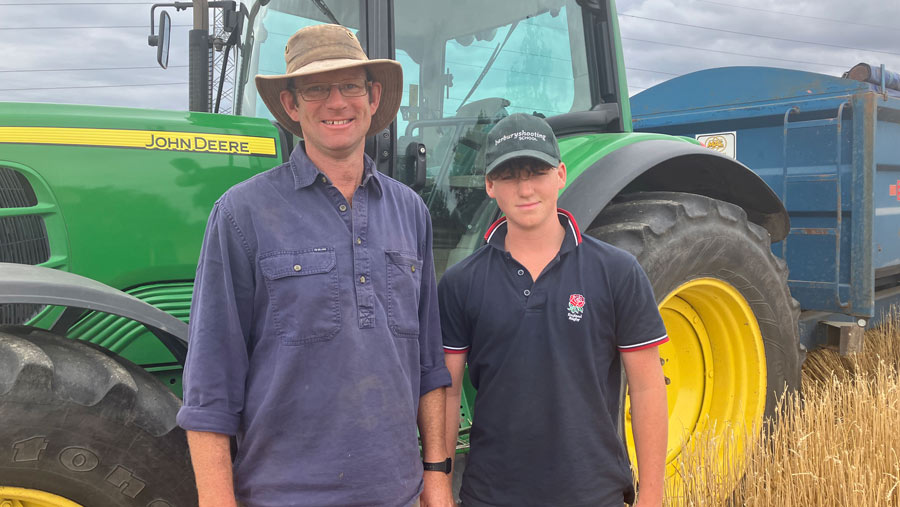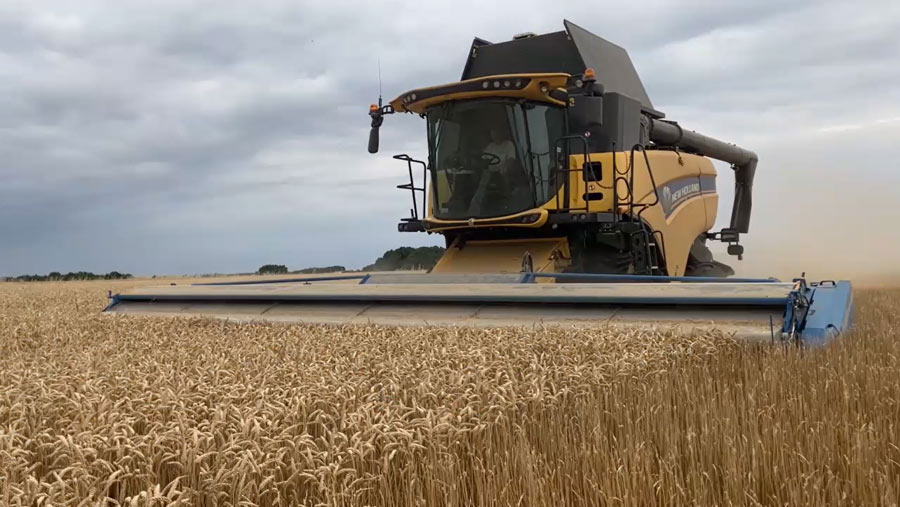Video: Harvest 2022 – Wilts farmer cuts no-fungicide wheat
George Hosier’s fungicide-free winter wheat harvest began two weeks earlier than usual on his Wiltshire holding, where his family have farmed for four generations.
The warm dry temperatures quickly brought crops on, and harvest of the 120ha wheat area started last Tuesday (26 July) using a stripper header, which cuts the wheat ears and leaves the straw standing.
First to be cut was a crop of Extase, which received just 120kg N/ha and zero applications of fungicide sprays. Yields averaged 8.5t/ha at a moisture content of 14.5%.
See also: Harvest 2022: Wheat holding up well despite month-early harvest
Specific weights performed well at 81kg/hl, thanks to a good level of light intensity throughout the growing season.
Mr Hosier says it was the very dry conditions – with average rainfall levels more than 200mm below normal for the first six months of the year – brought harvest forwards.
“On average we receive 480mm of rain from January to July, but we haven’t quite yet received 270mm,” he explains. With dry weather persisting, his wheat harvest was completed in just five days.
Nitrogen cuts
In a bid to build soil health and cut fuel costs by 50% Mr Hosier decided to go no-till eight years ago at Wexcombe Farm, near Malborough.
Over the past few years he has decided to slash costs further by significantly cutting back his nitrogen spend by more than 100kg/ha.
Nitrogen rates once stood as high as 230-240kg N/ha for milling wheat, and with a three spray fungicide programme achieving yields of 9-9.5t/ha it was a high-input system.
Undertaking a fungicide-free wheat programme for the past three years, while using a remarkable 120kg N/ha, production costs are now a fraction of what they were, and yields average 8-8.5t/ha.

George Hosier and son Fred © MAG/Emma Gillbard
“When we cut back nitrogen rates last year we may have cut too much too soon, but with fertiliser prices where they are we were well prepared for this season and are pleased with yields,” he says.
Growing the varieties Siskin and Skyfall as well, he admits that a few fields of Extase were sprayed with a dose of tebuconazole at T2.5 as a result of a breakthrough of yellow rust.
“We thought the wheat would hold off, but on a select few fields the yellow rust took hold so we had to spray.”
Stripper header
Rather than using a conventional header, Mr Hosier uses a Shelbourne Reynolds stripper header. This cuts the wheat ear off at the top of the stem, leaving the stem standing.
He then direct drills a cover crop mix into the straw, on which he outwinters his 200-head of beef cattle.
Mr Hosier says the stripper header is quicker and cheaper to run than a conventional one. Cutting at a speed of 7km/hr, it saves a significant amount of time and fuel at harvest as it eliminates the need to chop through a bulky crop of straw.

© MAG/Emma Gillbard
What’s more, it provides a perfectly even spread of organic matter across the field and, with fertiliser prices remaining high next season, this provides a free, powerful supply of P and K back to the soil and a good source of fibre for his cattle over the winter.
In fact, Mr Hosier cuts all his cereals using the stripper header. He occasionally bales a small proportion of straw for use on the farm but with winter housing now eliminated this demand has gone.
Usually, the 10-way cover crop mix would be direct drilled into the straw within 48 hours after harvest, but with such dry soil conditions, Mr Hosier is holding off for a week before going in with the John Deere 750 A disc drill.
Soil health
Since the shift in farming practices – going no-till, planting cover crops and use of herbal grass leys in the arable rotation – plant and soil health has greatly improved.
Soils are more biologically active and organic matter levels have increased by an average of 1% across Wexcombe Farm, with no purchased P and K applied – yet indices are climbing.
There has also been a noticeable change in biodiversity, with a greater abundance of birds and mammals – especially pheasants, hares and fallow deer.
Some of the farm’s more forward crops are looking about ready for cutting, and next on the harvest to-do list will be spring barley.
“The oats are changing very quickly and the linseed will hopefully hold on for a little longer,” says Mr Hosier.

